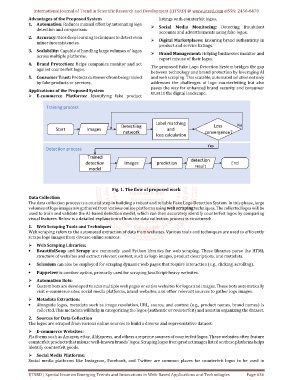Page 646 - Emerging Trends and Innovations in Web-Based Applications and Technologies
P. 646
International Journal of Trend in Scientific Research and Development (IJTSRD) @ www.ijtsrd.com eISSN: 2456-6470
Advantages of the Proposed System listings with counterfeit logos.
1. Automation: Reduces manual effort by automating logo Social Media Monitoring: Detecting fraudulent
detection and comparison.
accounts and advertisements using fake logos.
2. Accuracy: Uses deep learning techniques to detect even
Digital Marketplaces: Ensuring brand authenticity in
minor inconsistencies.
product and service listings.
3. Scalability: Capable of handling large volumes of logos Brand Management: Helping businesses monitor and
across multiple platforms.
report misuse of their logos.
4. Brand Protection: Helps companies monitor and act
The proposed Fake Logo Detection System bridges the gap
against counterfeit logos.
between technology and brand protection by leveraging AI
5. Consumer Trust: Protects customers from being misled and web scraping. This scalable, automated solution not only
by fake products or services. addresses the challenges of logo counterfeiting but also
paves the way for enhanced brand security and consumer
Applications of the Proposed System trust in the digital landscape.
E-commerce Platforms: Identifying fake product
Fig. 1. The flow of proposed work
Data Collection
The data collection process is a crucial step in building a robust and reliable Fake Logo Detection System. In this phase, large
volumes of logo images are gathered from various online platforms using web scraping techniques. The collected logos will be
used to train and validate the AI-based detection model, which can then accurately identify counterfeit logos by comparing
visual features. Below is a detailed explanation of how the data collection process is structured:
1. Web Scraping Tools and Techniques
Web scraping refers to the automated extraction of data from websites. Various tools and techniques are used to efficiently
scrape logo images from diverse online sources:
Web Scraping Libraries:
· BeautifulSoup and Scrapy are commonly used Python libraries for web scraping. These libraries parse the HTML
structure of websites and extract relevant content, such as logo images, product descriptions, and metadata.
· Selenium can also be employed for scraping dynamic web pages that require interaction (e.g., clicking, scrolling).
· Puppeteer is another option, primarily used for scraping JavaScript-heavy websites.
Automation Bots:
· Custom bots are developed to scan multiple web pages or entire websites for logos and images. These bots automatically
visit e-commerce sites, social media platforms, brand websites, and other relevant sources to gather logo images.
Metadata Extraction:
· Alongside logos, metadata such as image resolution, URL, source, and context (e.g., product names, brand names) is
collected. This metadata will help in categorizing the logos (authentic or counterfeit) and assist in organizing the dataset.
2. Sources for Data Collection
The logos are scraped from various online sources to build a diverse and representative dataset:
E-commerce Websites:
Platforms such as Amazon, eBay, AliExpress, and others are prime sources of counterfeit logos. These websites often feature
counterfeit products that misuse well-known brands' logos. Scraping logos from product images listed on these platforms helps
identify counterfeit goods.
Social Media Platforms:
Social media platforms like Instagram, Facebook, and Twitter are common places for counterfeit logos to be used in
IJTSRD | Special Issue on Emerging Trends and Innovations in Web-Based Applications and Technologies Page 636

